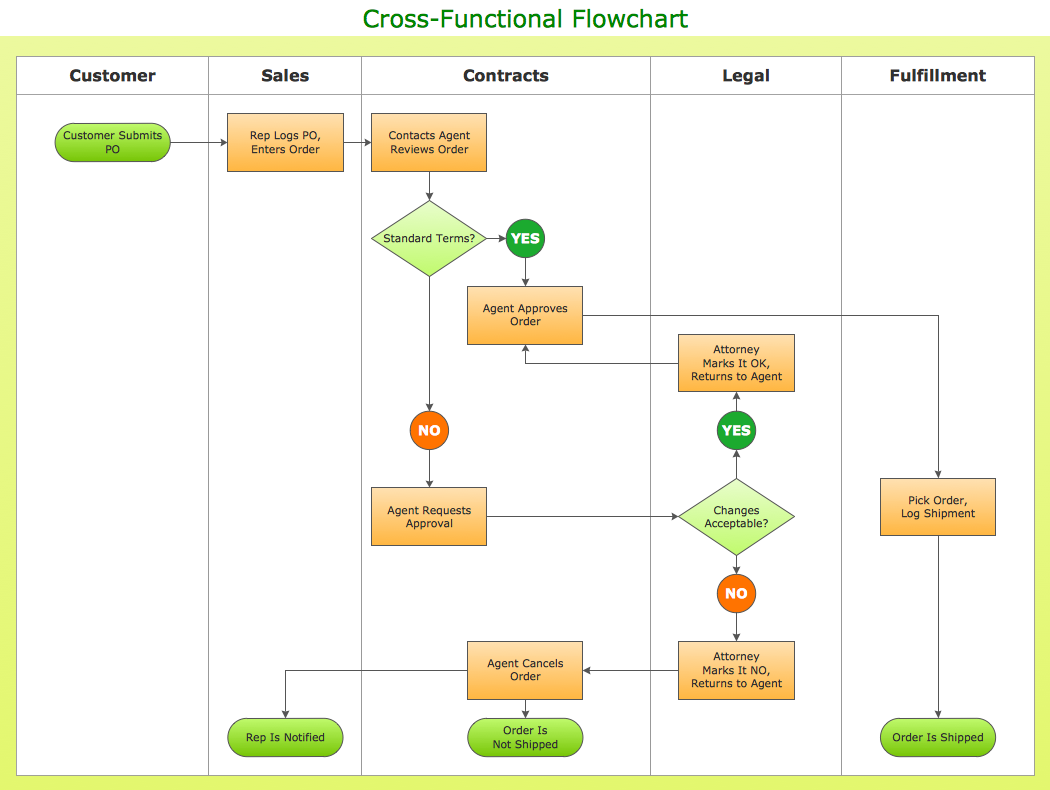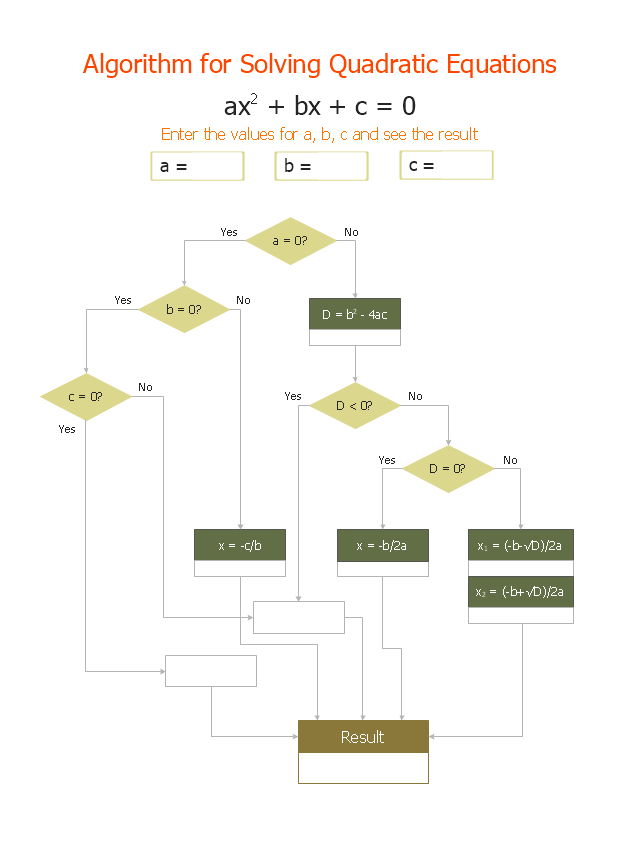Cross Functional Flowchart Shapes
When you are drawing a cross-functional flowchart with ConceptDraw Arrows10 Technology - you get it easily and fast. ConceptDraw Template library has more than enough versatility to draw any type of diagram with any degree of complexity. You will get a cross-functional flowchart with basic shapes which can be drawn in minutes, as the result."In elementary algebra, a quadratic equation (from the Latin quadratus for "square") is any equation having the form
ax^2+bx+c=0
where x represents an unknown, and a, b, and c are constants with a not equal to 0. If a = 0, then the equation is linear, not quadratic. The constants a, b, and c are called, respectively, the quadratic coefficient, the linear coefficient and the constant or free term.
Because the quadratic equation involves only one unknown, it is called "univariate". The quadratic equation only contains powers of x that are non-negative integers, and therefore it is a polynomial equation, and in particular it is a second degree polynomial equation since the greatest power is two.
Quadratic equations can be solved by a process known in American English as factoring and in other varieties of English as factorising, by completing the square, by using the quadratic formula, or by graphing." [Quadratic equation. Wikipedia]
The flowchart example "Solving quadratic equation algorithm" was created using the ConceptDraw PRO diagramming and vector drawing software extended with the Mathematics solution from the Science and Education area of ConceptDraw Solution Park.
ax^2+bx+c=0
where x represents an unknown, and a, b, and c are constants with a not equal to 0. If a = 0, then the equation is linear, not quadratic. The constants a, b, and c are called, respectively, the quadratic coefficient, the linear coefficient and the constant or free term.
Because the quadratic equation involves only one unknown, it is called "univariate". The quadratic equation only contains powers of x that are non-negative integers, and therefore it is a polynomial equation, and in particular it is a second degree polynomial equation since the greatest power is two.
Quadratic equations can be solved by a process known in American English as factoring and in other varieties of English as factorising, by completing the square, by using the quadratic formula, or by graphing." [Quadratic equation. Wikipedia]
The flowchart example "Solving quadratic equation algorithm" was created using the ConceptDraw PRO diagramming and vector drawing software extended with the Mathematics solution from the Science and Education area of ConceptDraw Solution Park.
- Basic Flowchart Symbols and Meaning | Cross Functional Flowchart ...
- Algorithms And Flowcharts To Solve Functions
- Types of Flowcharts | Types of Flowchart - Overview | Basic ...
- Algorithms And Flow Chart Videos Free Download
- Define Algorithms On Very General Basic Draw Flow Charts As
- Cross- Functional Flowchart | How To Draw Algorithms In Crossing ...
- Basic Flowchart Symbols and Meaning | Types of Flowcharts ...
- Basic Flowchart Symbols and Meaning | Types of Flowcharts ...
- Basic Flowchart Symbols and Meaning | Basic Audit Flowchart ...
- Basic Flowchart Symbols and Meaning | Audit Flowchart Symbols ...
- Cross- Functional Flowchart | Basic Flowchart Symbols and Meaning ...
- Diagram Flow Chart | Flow Chart Design - How to Design a Good ...
- Draw Flow Charts As Descriptive Algorithms
- Basic Flowchart Symbols and Meaning | Process Flowchart ...
- Basic Flowchart Symbols and Meaning | Business Process ...
- Diagram Flow Chart | Selection sorting method - Algorithm flowchart ...
- Algorithms And Flowcharts In Programming
- Swim Lane Flowchart Symbols | Cross- Functional Flowchart (Swim ...
- Algorithms For Function Procedure For Ticket Bookings
- Cross Functional Flowchart Symbols For Email

